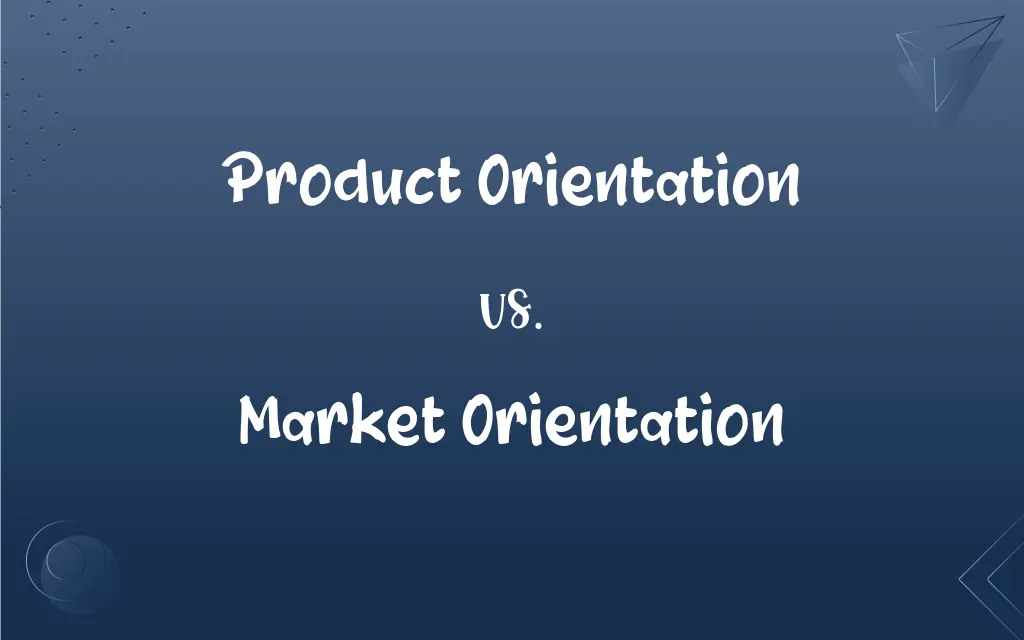Product Orientation vs. Market Orientation: What's the Difference?
Edited by Aimie Carlson || By Harlon Moss || Published on December 25, 2023
Product orientation focuses on product quality and innovation, whereas market orientation prioritizes customer needs and market trends.

Key Differences
Product orientation is a business philosophy that emphasizes the quality and attributes of the product itself. Companies with this orientation invest heavily in research and development to create superior products. Conversely, market orientation is a strategy that centers on understanding and meeting the needs and preferences of customers. Businesses with a market orientation continuously gather and analyze market data to align their products with customer demands.
In product orientation, the primary belief is that a good product will naturally find its market due to its inherent quality. This approach often leads to significant innovations, as the focus is on making the product the best in its category. On the other hand, market orientation involves tailoring products and services to fit existing market needs, relying on market research and customer feedback to guide product development.
Product orientation can sometimes lead to a disconnect with the market if consumer preferences are not considered, potentially resulting in products that are technically superior but lack market appeal. In contrast, market orientation runs the risk of being overly reactive to current market trends, potentially leading to a lack of long-term vision and innovation.
Companies with a product orientation pride themselves on their expertise and ability to push technological or design boundaries. This approach is often seen in industries where technological advancement is rapid. Market orientation, however, is more common in highly competitive markets where understanding and responding to customer needs is crucial for survival and success.
Product-oriented companies may struggle in rapidly changing markets if they are too focused on their product and not enough on evolving market trends. Market-oriented companies, while adaptive, may face challenges in differentiating themselves if they focus too heavily on current market demands without innovating.
ADVERTISEMENT
Comparison Chart
Focus
On the product's quality and innovation.
On customer needs and market trends.
Strategy
Innovate and improve product features.
Adapt to and anticipate market changes.
Risk
Ignoring market needs and trends.
Over-reliance on current market demands.
Advantage
Potential for groundbreaking innovation.
Alignment with customer preferences.
Typical Industries
Technology, luxury goods.
Consumer goods, services.
ADVERTISEMENT
Product Orientation and Market Orientation Definitions
Product Orientation
Prioritizing product development over market research.
Nikon’s product orientation emphasizes superior camera technology.
Market Orientation
Adaptation of products based on market research.
Netflix’s market orientation involves creating content based on viewer trends.
Product Orientation
Focus on product features and capabilities.
Tesla’s product orientation results in cars with advanced electric technology.
Market Orientation
Aligning product strategies with market demands.
Zara’s market orientation results in fast fashion aligned with current trends.
Product Orientation
Concentration on technological advancement in products.
Intel’s product orientation drives innovation in microprocessor technology.
Market Orientation
Responsiveness to changes in market conditions.
Samsung’s market orientation allows quick adaptation to smartphone market shifts.
Product Orientation
Belief in the product's inherent value to attract customers.
Rolex’s product orientation relies on the prestige and quality of its watches.
Market Orientation
Focus on customer needs and market trends.
Amazon’s market orientation leads to a wide product range catering to consumer preferences.
Product Orientation
Emphasis on product quality and innovation.
Apple’s product orientation leads to groundbreaking devices like the iPhone.
Market Orientation
Emphasis on customer feedback in shaping products.
McDonald’s market orientation reflects in menu items tailored to regional tastes.
FAQs
Can a company be both product and market-oriented?
Yes, some companies blend both approaches for balanced strategies.
How does product orientation differ from market orientation?
Product orientation focuses on the product, while market orientation focuses on the market and customer needs.
What is product orientation?
A business approach focusing on product quality and innovation.
Can market orientation stifle innovation?
Overemphasis on market trends can sometimes limit innovation.
Is product orientation riskier than market orientation?
Yes, if consumer preferences and market trends are overlooked.
What is market orientation?
A strategy centered on understanding and satisfying customer needs.
Can market orientation lead to short-termism?
Yes, if the focus is only on current trends without a long-term vision.
Do market-oriented companies disregard product quality?
No, they prioritize customer needs but also consider product quality.
Is product orientation suitable for all industries?
It's more suited for industries where product innovation is key.
How do established companies benefit from market orientation?
It helps them stay competitive by aligning with market demands.
How does product orientation impact innovation?
It often leads to significant technological or design advancements.
How does market research play a role in market orientation?
It's critical for understanding and responding to customer needs.
How important is customer feedback in market orientation?
It's essential for shaping products and services.
How does a company transition from product to market orientation?
By incorporating more customer feedback and market research into decision-making.
What are the challenges of product orientation?
Difficulty in adapting to market changes and customer preferences.
Is one orientation better than the other?
It depends on the company's goals, industry, and market conditions.
Are startups more likely to be product-oriented?
Many startups focus on innovative products, showing product orientation.
Do product-oriented companies ignore their customers?
Not necessarily, but their main focus is on the product itself.
Can a strong brand be built with product orientation?
Yes, through unique and high-quality products.
Does market orientation guarantee customer satisfaction?
It increases the likelihood, but isn't a guarantee.
About Author
Written by
Harlon MossHarlon is a seasoned quality moderator and accomplished content writer for Difference Wiki. An alumnus of the prestigious University of California, he earned his degree in Computer Science. Leveraging his academic background, Harlon brings a meticulous and informed perspective to his work, ensuring content accuracy and excellence.
Edited by
Aimie CarlsonAimie Carlson, holding a master's degree in English literature, is a fervent English language enthusiast. She lends her writing talents to Difference Wiki, a prominent website that specializes in comparisons, offering readers insightful analyses that both captivate and inform.

































































